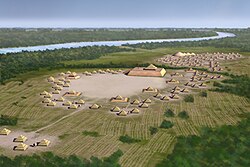Spiro Mounds
|
Spiro Mound Group
|
|

Artists conception of Spiro Mounds as seen from the west.
|
|
| Nearest city | Spiro, Oklahoma |
|---|---|
| Coordinates | 35°18′43″N 94°34′07″W / 35.31194°N 94.56861°WCoordinates: 35°18′43″N 94°34′07″W / 35.31194°N 94.56861°W |
| Area | Le Flore County |
| Architectural style | Mississippian |
| NRHP Reference # | 69000153 |
| Added to NRHP | September 30, 1969 |
Spiro Mounds (34 LF 40) is an important Mississippian archaeological site located in what is now Eastern Oklahoma. It lies near the Arkansas River seven miles north of the town of Spiro. Between the 9th and 15th centuries, the Spiro people created a powerful religious and political center based on the model of Mississippian Culture that thrived along the Mississippi River and its tributaries at that period. Spiro is considered the western-most outpost of Mississippian culture. Spiro Mounds is under the protection of the Oklahoma Historical Society, and is listed on the National Register of Historic Places.
In the 1930s during the Great Depression treasure hunters bought the rights to tunnel into Craig Mound—the second-largest mound on the site—to mine it for artifacts. They exposed a hollow burial chamber inside the mound, a unique feature containing some of the most extraordinary pre-Columbian artifacts ever found in North America, including some of fragile materials: textiles and feathers uniquely preserved in the chamber. The treasure hunters sold the artifacts they recovered to art collectors, some as far away as Europe. Some of these artifacts were later returned, though some have never been accounted for. This site has been significant for North American archaeology since the 1930s, especially for defining the Southeastern Ceremonial Complex, a significant feature of the Mississippian tradition and a unifying element of culture extending into the American Southeast.
Mississippian culture spread along the lower Mississippi River and its tributaries between the 9th and 16th centuries. The largest Mississippian settlement was Cahokia, the capital of a major chiefdom that built a six-mile-square city east of what is now St. Louis, Missouri in present-day Southern Illinois. Mississippian culture ranged from the Great Lakes to the Gulf Coast, and along the Ohio River and into both the lowland and mountain areas of the Southeast. Mississippian settlements were known for their large platform earthwork mounds (usually truncated pyramids) surmounted by temples, the houses of warrior kings and priests, and the burial houses of the elite. Archaeological research has shown that Mississippian settlements like Cahokia and Spiro took part in a vast trading network that covered the eastern half of what is now the U.S. and parts of what is now the Western U.S. as well.
...
Wikipedia


